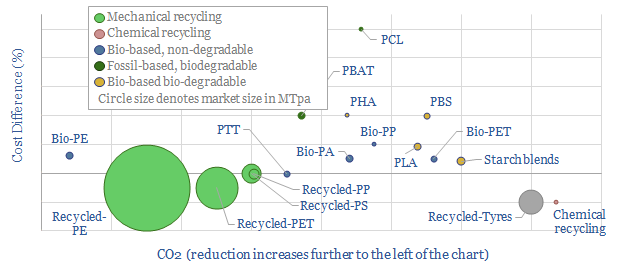This data-file is an overview of bioplastics, biodegradable plastics and recycled plastics. It captures c10% of the global plastics market that is derived from mechanical recycling, from biologically-sourced feedstocks or that is bio-degradable.
How much bioplastic is produced globally? 1.8MTpa of next-gen plastics are produced globally. 0.8MTpa are bioplastics in the sense that they are derived from biomass (but not bio-degradable), 0.3MTpa are bioplastics in the sense that they are biodegradable (but not derived from biomass), and 0.7MTpa are both bio-degradable and bio-plastics.
Biodegradable is a spectrum. The leader in our screen is PBAT. BASF’s PBAT, ecoflex, product degrades by c90% after 80-days. But it is derived from fossil fuels not biomass.
Biodegradable plastic derived from biomass is likely c30% lower in CO2 than conventional plastics, but around 2x more costly (research note here). The economics of the ethanol-to-ethylene chemical pathway are modelled here. Biomass-derived olefins can be further processed via standard polymerization, modelled here.
Bioplastic production volumes are still quite small, equivalent to <0.5% of all global plastics. For perspective, the total plastics market is around 450MTpa, and likely to reach 800MTpa by 2050 (please see our model of global plastic demand).
We have also evaluated some emerging bio-plastic companies in our broader research, such as Lanzatech, Origin Materials and Danimer.
Good old mechanical recycling is around 50MTpa, c50% lower-carbon, c20% lower-cost, so should not be overlooked. Mechanical recycling tends to reduce CO2 by 50% and cost less than virgin plastic. But only c25% of plastic is well-suited to mechanical recycling. All of our recycling research is linked here.
Next-generation plastic recycling is covered in our research linked here. After a challenging pathway to de-risking this technology, we see front-runners emerging, such Agilyx, Alterra and Plastic Energy.
The data-file reviews seventeen distinct plastic products, estimating the market sizes, CO2 levels, costs, production processes, uses and other notes from technical papers.
